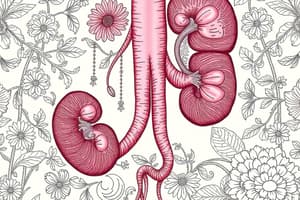Podcast
Questions and Answers
What is a significant consequence of untreated hydronephrosis?
What is a significant consequence of untreated hydronephrosis?
- Gradual loss of renal function (correct)
- Complete resolution of kidney stones
- Temporary increase in urine production
- Improved urinary flow
Which clinical manifestation is typically associated with acute hydronephrosis?
Which clinical manifestation is typically associated with acute hydronephrosis?
- Acute, colicky flank or back pain (correct)
- Dull, aching flank pain
- Chronic fevers with no pain
- Possibly asymptomatic
What is a common therapeutic approach for managing kidney stones?
What is a common therapeutic approach for managing kidney stones?
- Antibiotics without other treatments
- Immediate surgical intervention for all cases
- Hydration and dietary modification (correct)
- Psychological assessment for recurrent stones
Chronic hydronephrosis can be asymptomatic. Which of the following is a possible symptom if it progresses?
Chronic hydronephrosis can be asymptomatic. Which of the following is a possible symptom if it progresses?
Which of the following pain characteristics is associated with ureteral stones?
Which of the following pain characteristics is associated with ureteral stones?
What clinical therapy is indicated for managing acute hydronephrosis?
What clinical therapy is indicated for managing acute hydronephrosis?
Which symptom can indicate significant hydronephrosis?
Which symptom can indicate significant hydronephrosis?
Which of the following symptoms is NOT typically associated with chronic hydronephrosis?
Which of the following symptoms is NOT typically associated with chronic hydronephrosis?
Study Notes
Urinary Tract Obstruction
- Can happen anywhere in the urinary tract, from the kidney to the urethra.
- Causes urine to back up, leading to:
- Hydronephrosis (swelling of the kidneys)
- Increased risk of infection
- Slow obstruction may have few or no symptoms.
- Sudden obstruction can lead to severe symptoms and even kidney failure.
Hydronephrosis
- Occurs when urine flow is blocked, leading to buildup in the kidneys.
- Increased pressure stretches the urinary tract.
- If pressure isn't relieved:
- Damage to kidney filtering parts
- Gradual loss of kidney function
Clinical Manifestations and Treatments
Acute Hydronephrosis
- Symptoms:
- Sudden, intense pain in the side or back
- Pain that can spread to the groin
- Blood in the urine
- Pus in the urine (sign of infection)
- Fever, nausea, vomiting, abdominal pain
- Treatments:
- Fluids given by IV
- Medications based on the stone's composition
- Breaking up the stone (lithotripsy) or surgery
- Changing diet
- Monitoring kidney function
- Patient education to reduce risk factors
Chronic Hydronephrosis
- Symptoms:
- May have no symptoms until the obstruction is complete
- Dull, aching pain in the side or back
- Blood in the urine
- Signs of urinary tract infection (UTI): pus in the urine, fever, discomfort
- A mass that can be felt in the side (in severe cases)
- Treatments:
- Checking kidney function
- Changing diet
- Fluids given by IV
- Breaking up the stone (lithotripsy) or surgery
- Patient education to reduce risk of recurrence
Kidney Stones
- Symptoms:
- Often no symptoms
- Dull, aching pain in the side or back
- Microscopic blood in the urine
- Signs of UTI
Ureteral Stones
- Symptoms:
- Severe, sudden pain in the side or back (renal colic)
- Pain that can spread to the lower abdomen, groin, and genitals
- Nausea and vomiting
- Pale skin
- Cold, clammy skin
- Treatments:
- Drinking plenty of fluids
- Changing diet
- Medications based on the stone's composition
- Pain relievers (like morphine)
- NSAIDs (like indomethacin)
Bladder Stones
- Symptoms:
- May have no symptoms
- Dull pain in the lower abdomen, especially with exercise or urination
- Blood in the urine (visible or microscopic)
- Signs of UTI
Hydronephrosis Summary
Acute
- Causes sudden, intense pain that can spread to the groin.
Chronic
- Develops slowly and often has few symptoms, possibly dull back or side pain.
- A palpable mass may indicate significant hydronephrosis.
- Other symptoms can include nausea, vomiting, abdominal pain, blood in the urine, and signs of UTI (pus in the urine, fever).
Infection Risk
- Increased risk of UTIs (upper and lower) due to urine buildup caused by obstruction.
Collaborative Care for Urinary Calculi (Stones)
- Goal:
- Relieve acute symptoms
- Remove or break down stones
- Prevent new stones from forming
Asymptomatic Stones
- Managed conservatively as an outpatient.
Urgent Treatment
- Based on:
- Location of the stone
- Severity of blockage
- Pain level
- Bleeding
- Kidney function
- Presence of UTI
Studying That Suits You
Use AI to generate personalized quizzes and flashcards to suit your learning preferences.
Description
This quiz covers urinary tract obstruction and hydronephrosis, exploring their causes, symptoms, and treatment options. Learn about the implications of slow versus sudden obstruction and the clinical manifestations associated with acute hydronephrosis. Test your knowledge on this critical area of urology.




